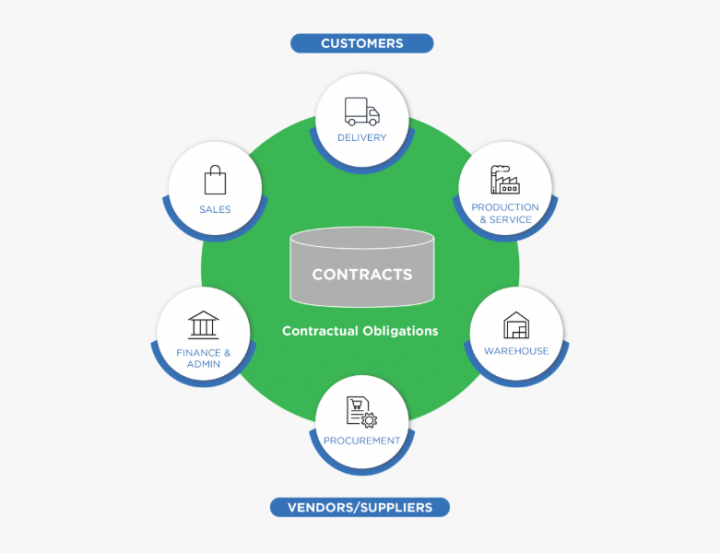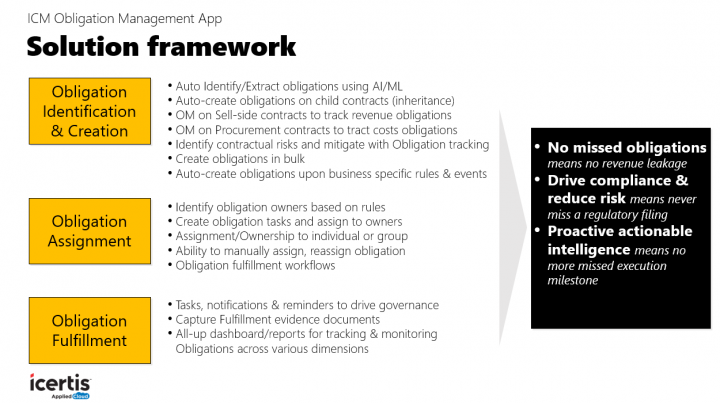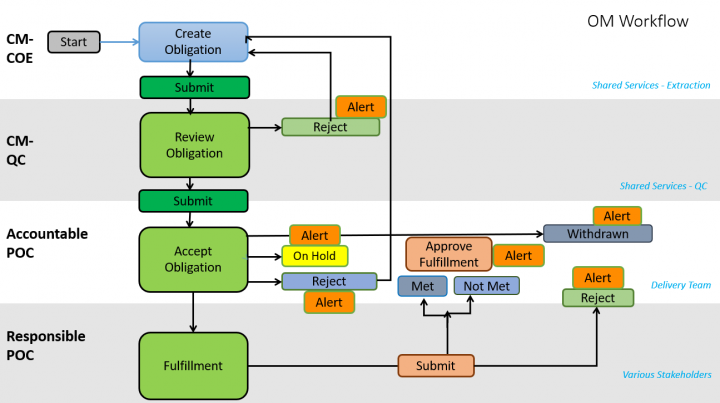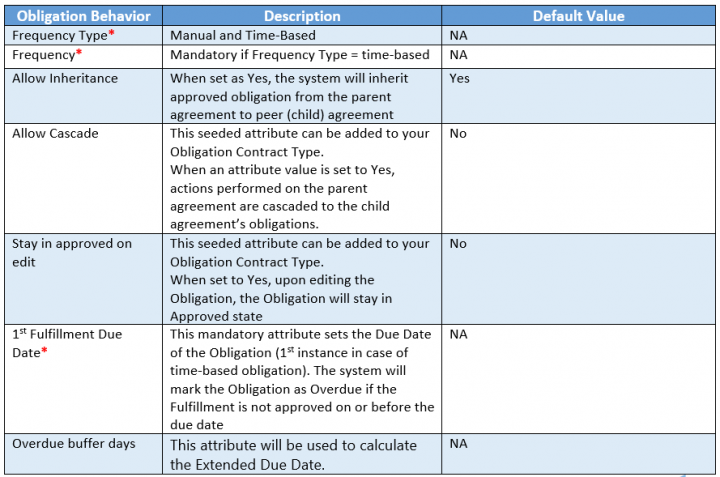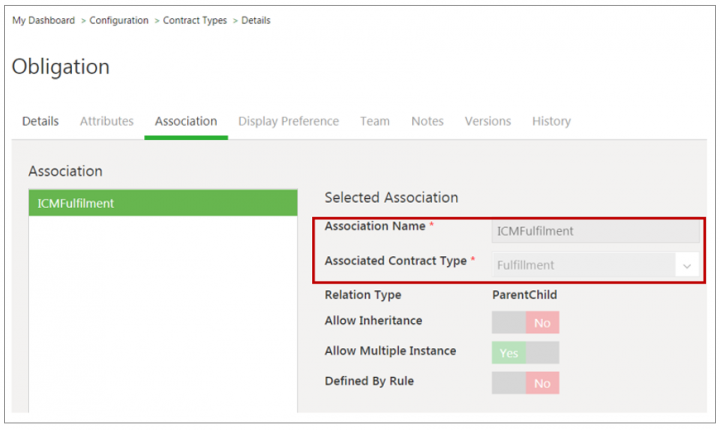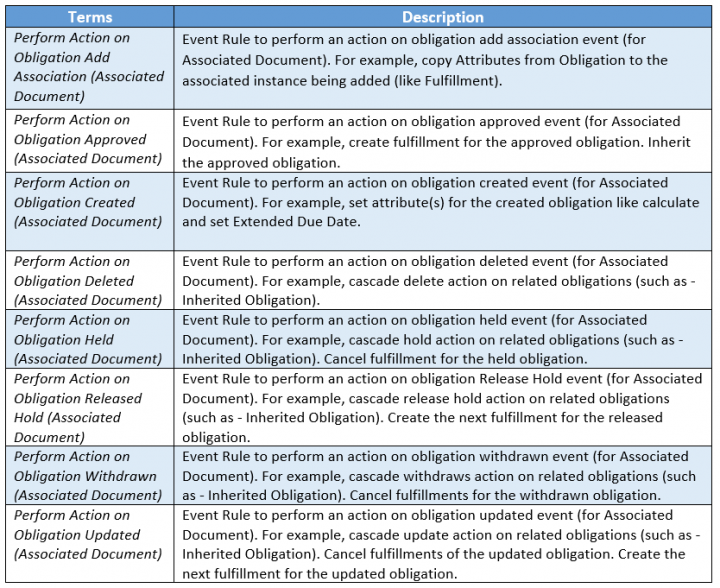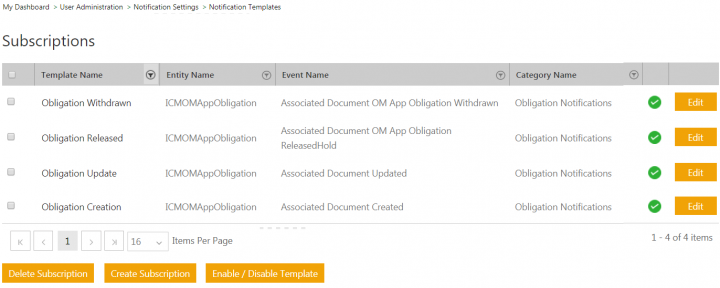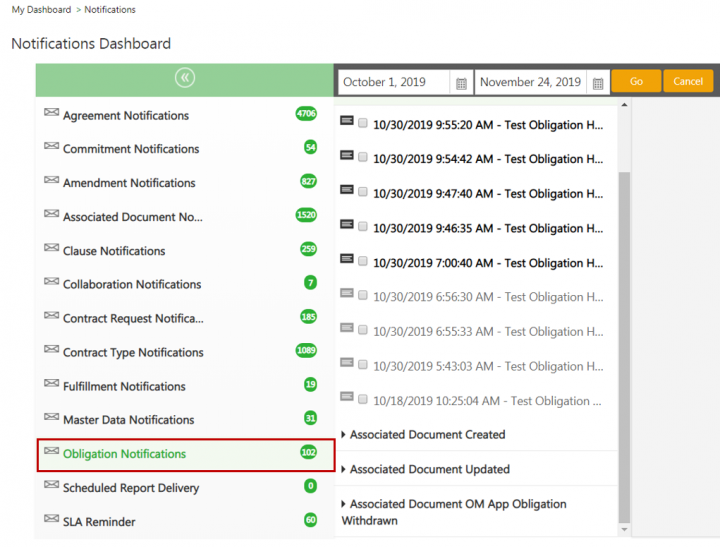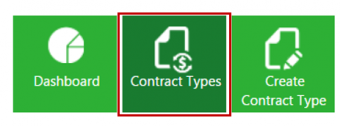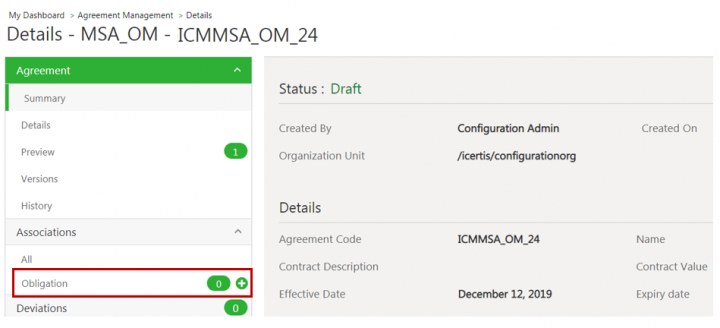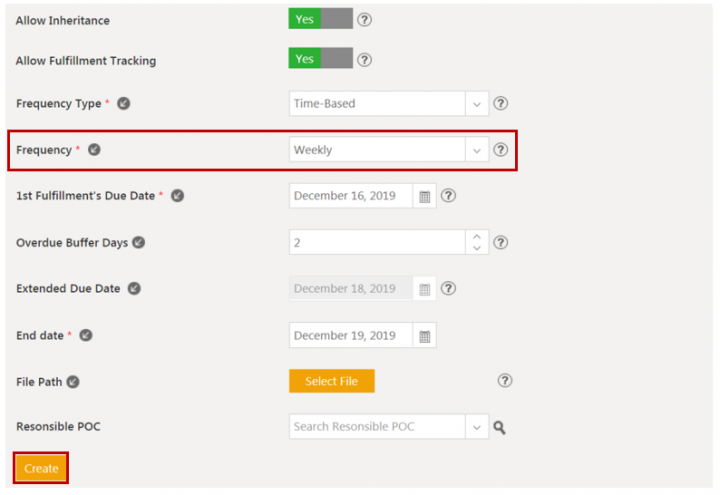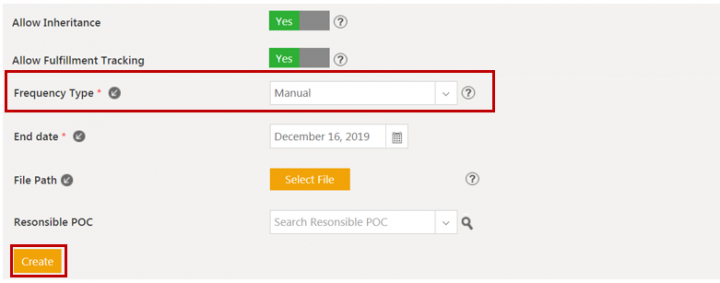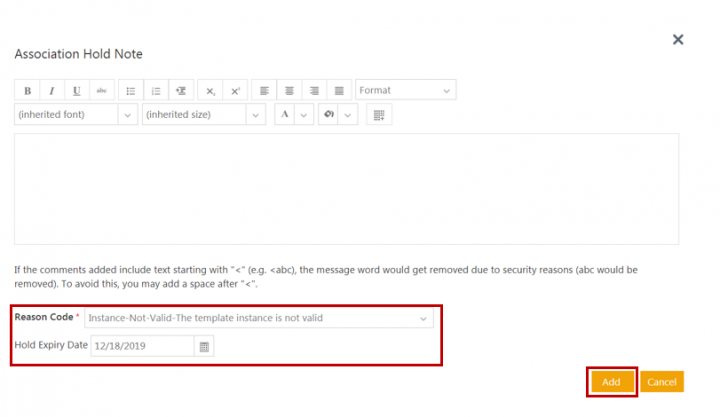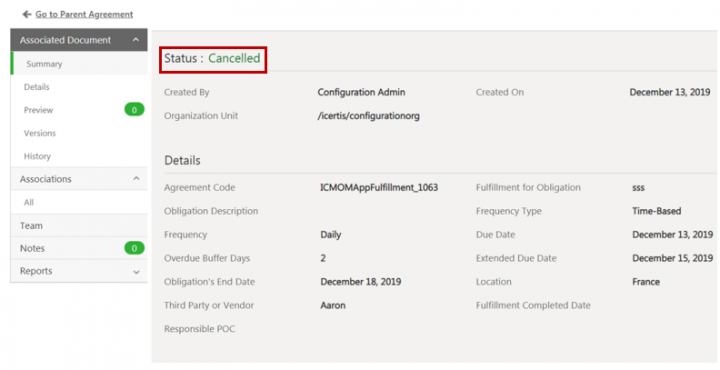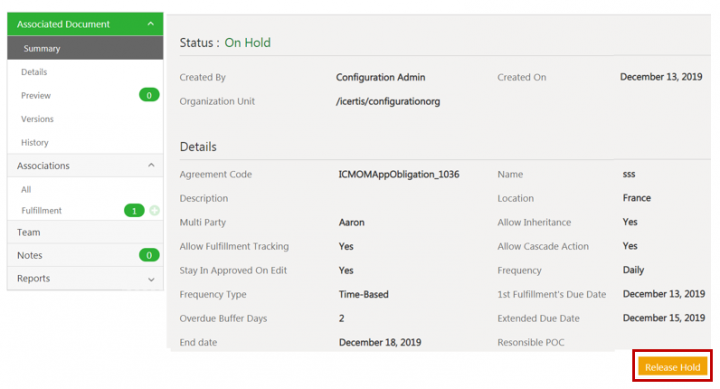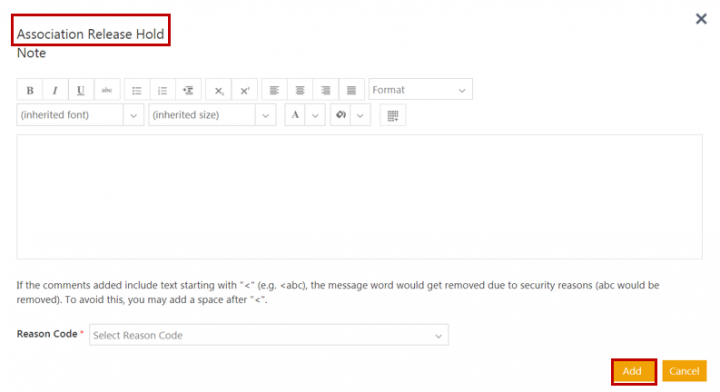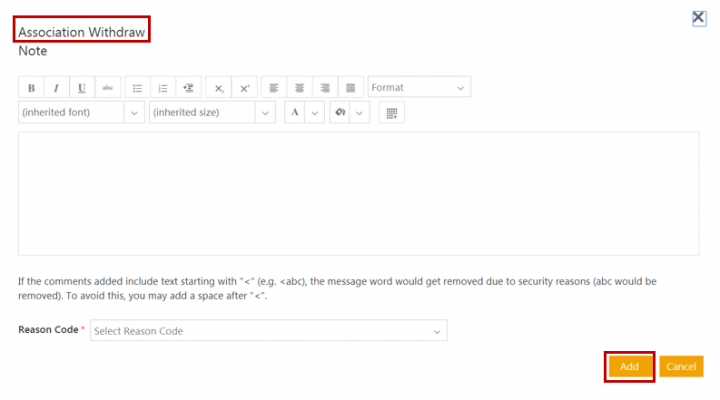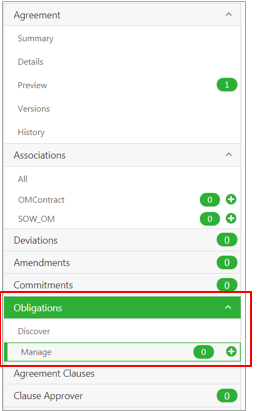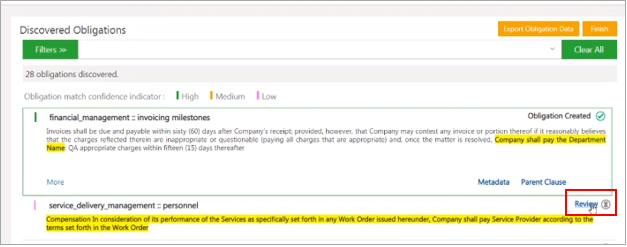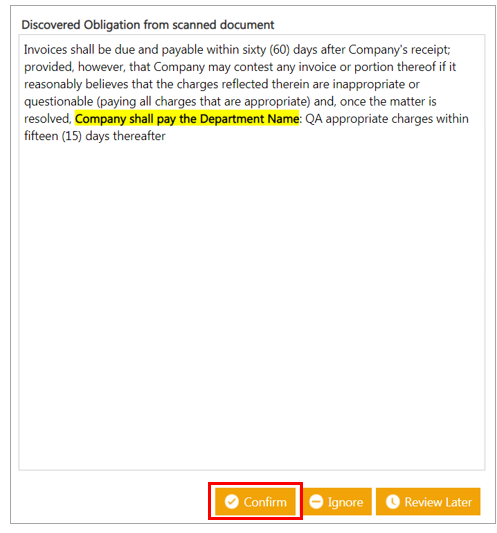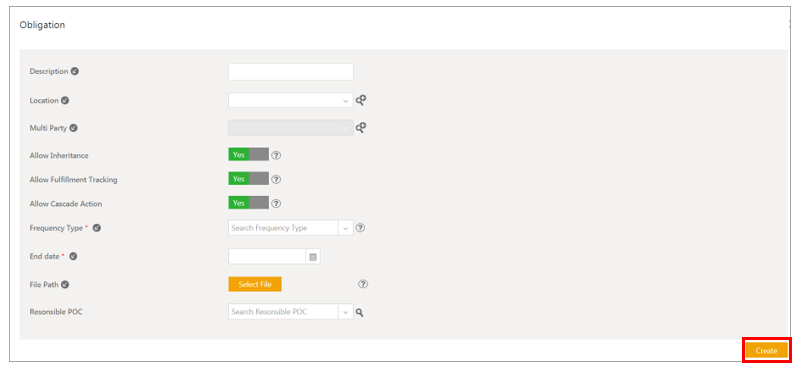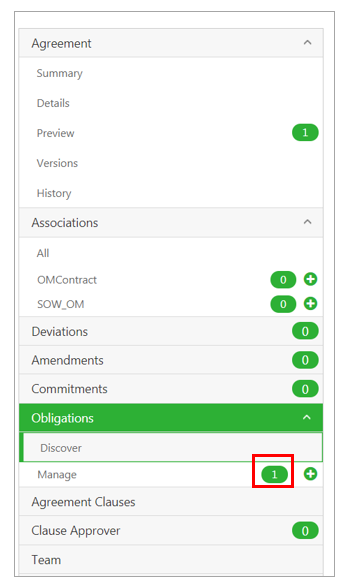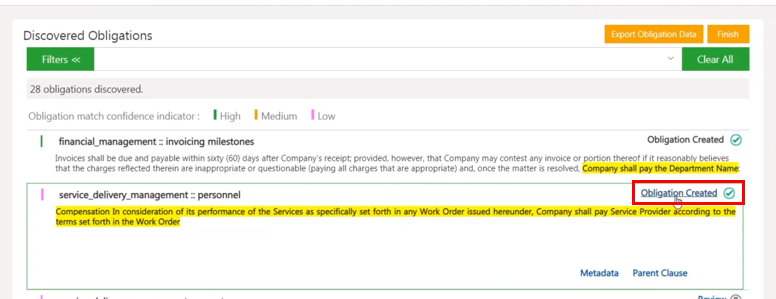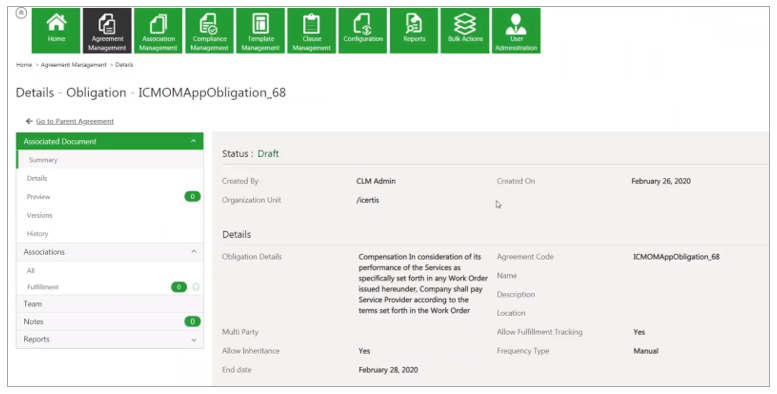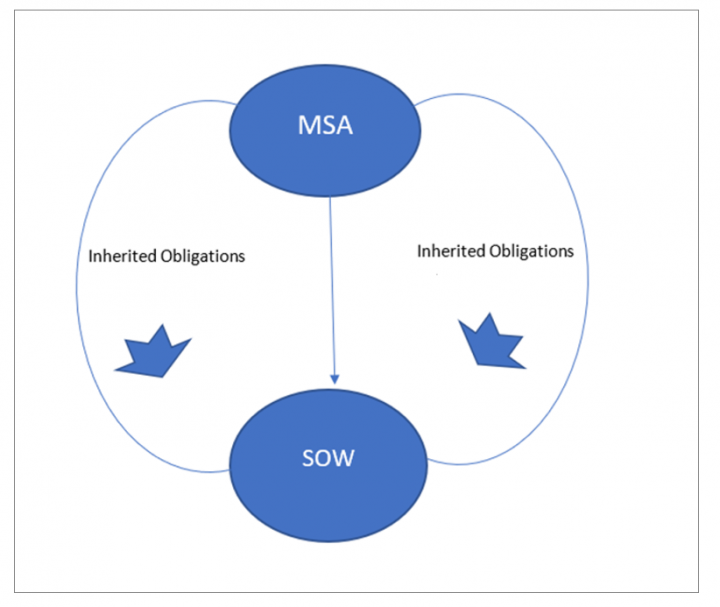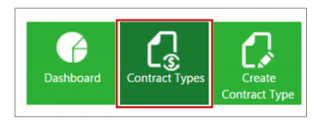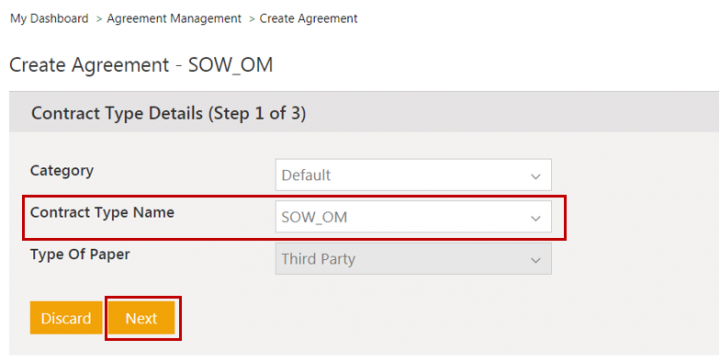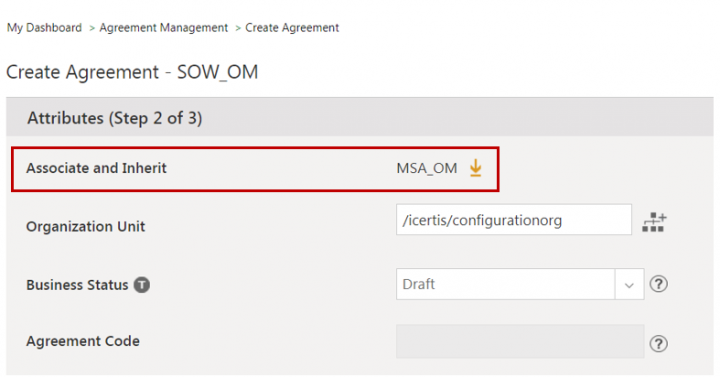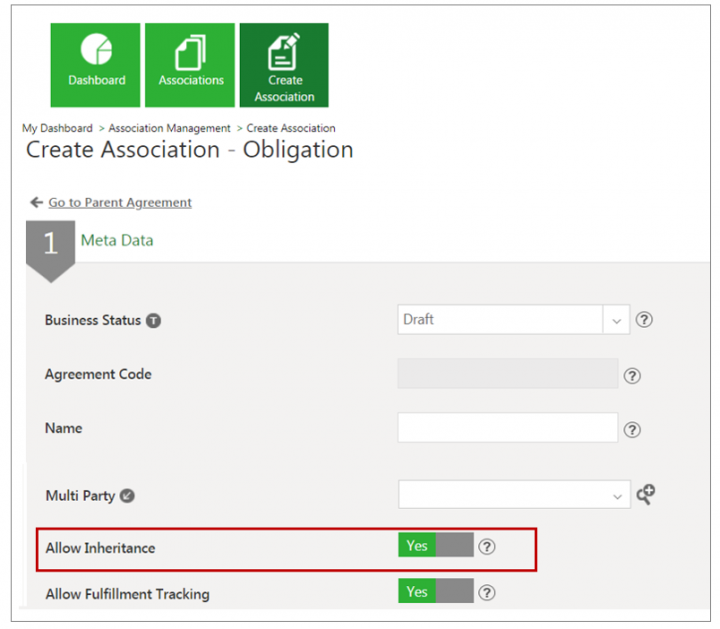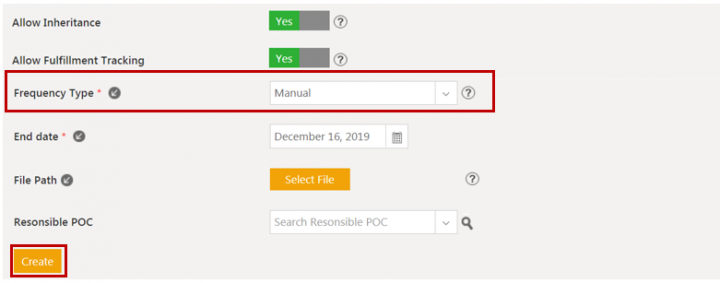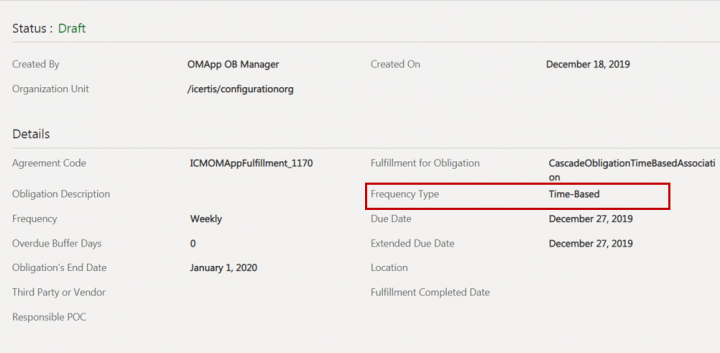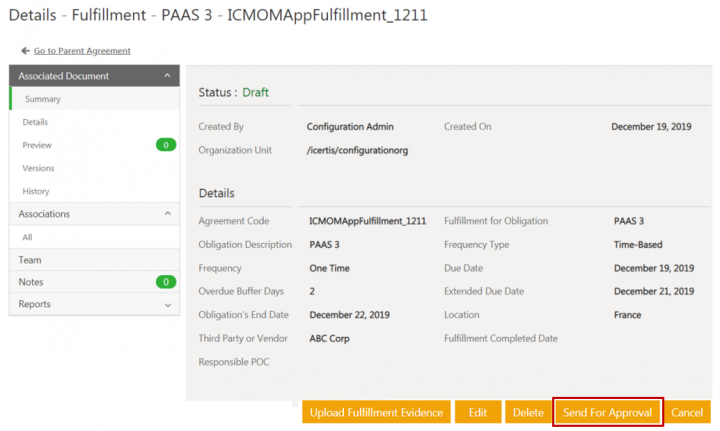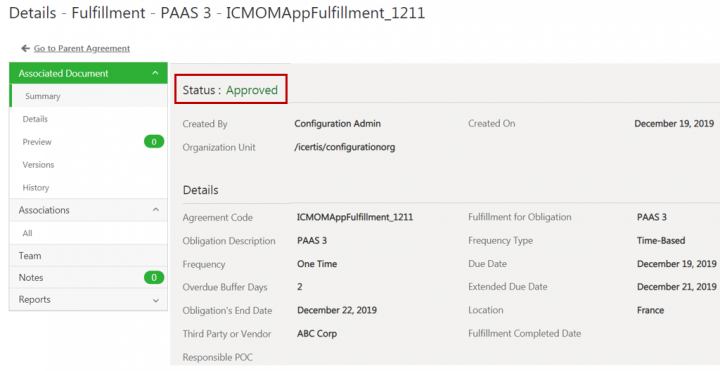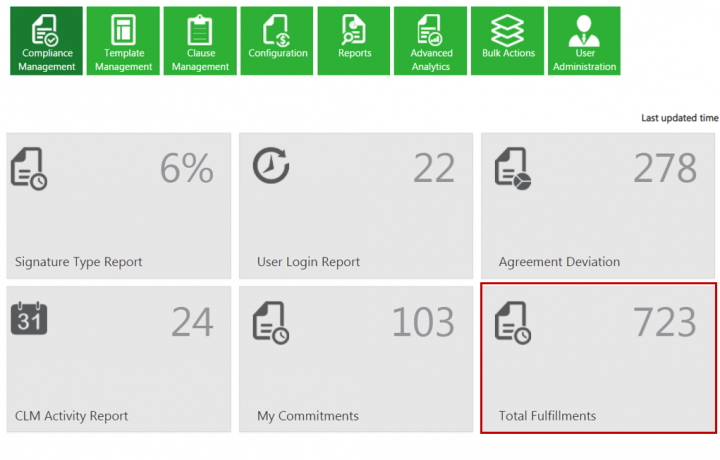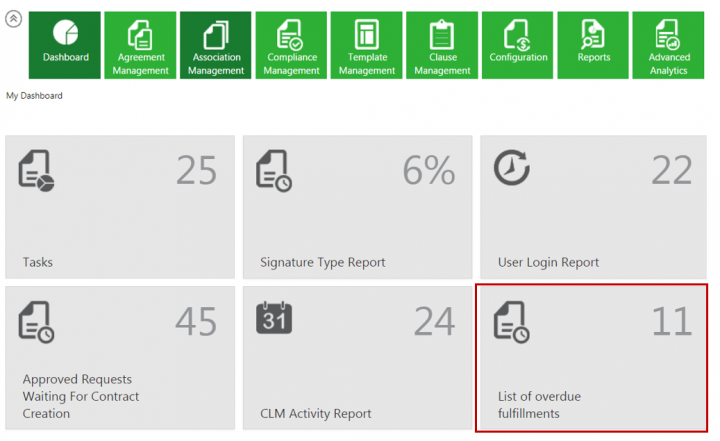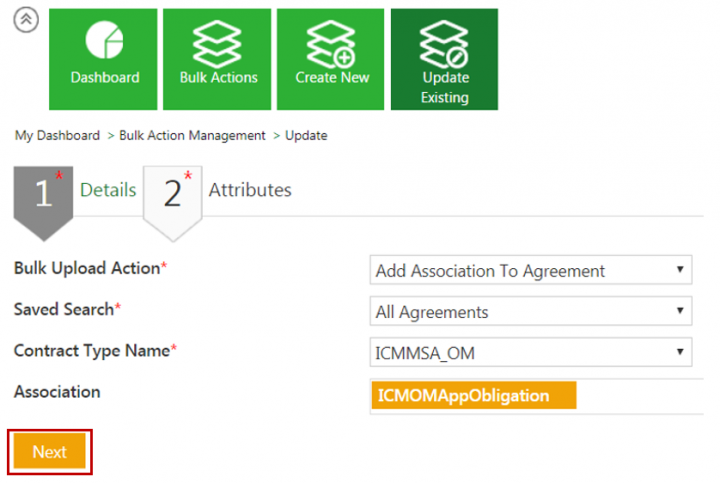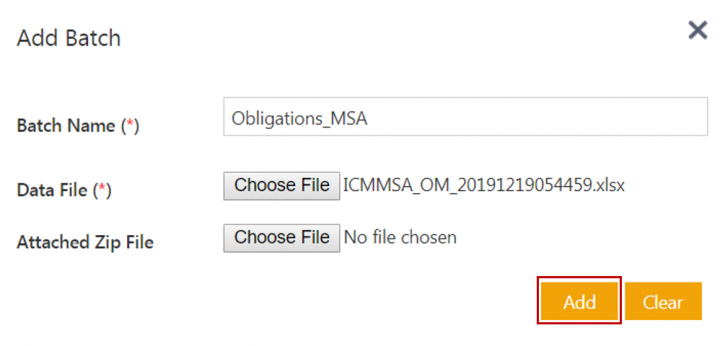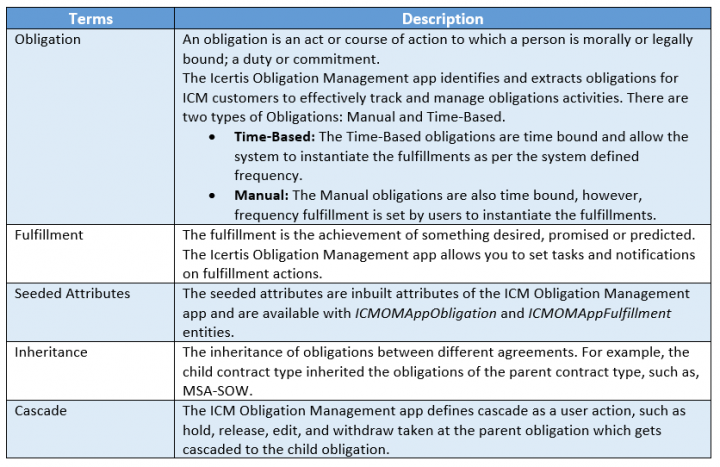Contents
- 1 ICI Obligation Management
- 1.1 Purpose of the Document
- 1.2 The Prerequisites
- 1.3 Overview
- 1.4 The Obligation Management Process
- 1.5 Working with Obligations
- 1.6 Configuring your existing Agreement Contract Type to manage Obligations
- 1.7 Creating an Obligation for an Agreement
- 1.8 Integrating Obligation AI with Obligation
- 1.9 Inheriting Obligations
- 1.10 Working with Fulfillments
- 1.11 Creating & Editing Fulfillments
- 1.12 Configuring Reports
- 1.13 Creating Obligations in Bulk using Bulk Actions
- 1.14 Glossary
- 1.15 Known Issues
ICI Obligation Management
In the evolving landscape for Enterprise Contract Management, proactive obligations management is playing a critical role. Tracking the obligations enshrined in contracts is critical to an enterprise’s understanding of whether the business is proceeding as planned and taking proactive steps to correct the course if not.
Non-compliance on obligations not only hurts performance, but also can expose businesses to substantial risks – including reputational damage, financial loss, and soured partner relationships
With this release, the ICI Obligation Management Application has been enhanced to enable companies achieve contractual compliance at an enterprise scale. Built on the ICI platform, the ICI Obligation Management app transforms how organizations identify, create, manage and fulfill obligations that were previously hidden in complex contract language. The app includes OOTB constructs for “Obligations” & “Fulfillments” assisted by powerful rule-based obligation ownership, workflow tools to ensure seamless obligation fulfillment, and sophisticated analytics – all designed to protect your business and maximize the ROI of your relationships. You can configure existing or new ICI Agreements to be able to manage Obligations.
The benefits of the Obligation Management App include the ability to:
- Identify the contractual obligations from different ICI signed contracts
- Create fulfillments from the identified contractual obligation
- Review obligations and related fulfillments
- Inherit contractual obligations from one contract to another
- Assign appropriate users assigned to your obligation and fulfillments
- Drive obligation and its related fulfillments to completion and giving you workflow controls (hold, withdraw, and cancel)
- Monitor your obligations and its business impact
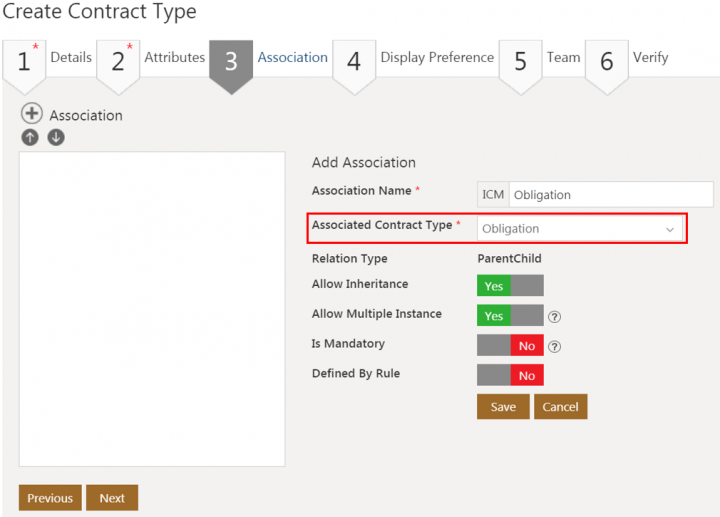
Figure 1: Configure your agreement contract types to add the association to the Obligation. This will start tracking Obligations lifecycle for your agreements
Purpose of the Document
The purpose of this document is to:
- Introduce the ICI Obligation Management App and how it fits into the enterprise contract management workflow.
- Describe the business context and solution framework for ICI Obligation Management App
- Describe how the obligation Management is built on the ICI platform and how to set up and configure for your implementation needs.
- Describe the Config, Workflow for managing the Obligation life cycle.
The Prerequisites
The user must have:
- Completed ICI Platform Training
- Obligation Management Application must be enabled on the customer environment
Overview
In this fast-paced business scenario, the relevance of Enterprise Contract Management (ECM) to handle global contracts has grown manifold. Contracts establish a working model for a business to reach a future desired state: It defines the rules of business interaction and defines how business outcomes will be achieved. Yet until business parties live up to the plan, those outcomes are not ensured.
Therefore, tracking the obligations enshrined in contracts is critical to an enterprise’s understanding of whether the business is proceeding as planned and taking proactive steps to correct the course if not.
Non-compliance on obligations not only hurts performance, but also can expose businesses to substantial risks – including reputational damage, financial loss, and soured partner relationships.
The ICI Obligation Management Application built and designed along with the line of Icertis Contract Intelligence (ICI) platform (a world leader in Contract Lifecycle Management) and provides OOTB Obligation & Fulfillment objects and their workflow. Like everything on ICI, the OM app is highly configurable and extendible to suit customer requirements.
The Challenge
Contracts establish a working model for a business to reach a future desired state: It defines the rules of business and defines how business outcomes will be achieved. Yet until business parties live up to the plan, those outcomes are not ensured. Therefore, tracking the obligations enshrined in contracts is critical to an enterprise’s understanding of whether the business is proceeding as planned and taking proactive steps to correct the course if not.
Yet holistic management of obligations in an enterprise is easier said than done. Manually managing obligations--as well as SLAs, and entitlements--enshrined in contract clauses and terms has many challenges, from the sheer number of obligations found in contracts to the complexity of identifying & fulfilling them.
A major impediment to tracking obligation fulfillment is the enterprise-wide nature of obligations themselves: One department creates a contract, but the onus to fulfill contractual obligations is usually on another department in the real world. This is a common scenario with manufacturers of complex products, like airplanes, automobiles, drugs, etc. The sales team at the airplane manufacturer accommodates an airline’s requirements in the contract to close the deal, but it is up to the sourcing department to buy the goods & services needed to meet those requirements and maybe the customer services department to fulfill the warranty related commitments.
Consider this model to see how typical contract management leaves obligations siloed within departments, hindering visibility, tracking, and ultimately performance.
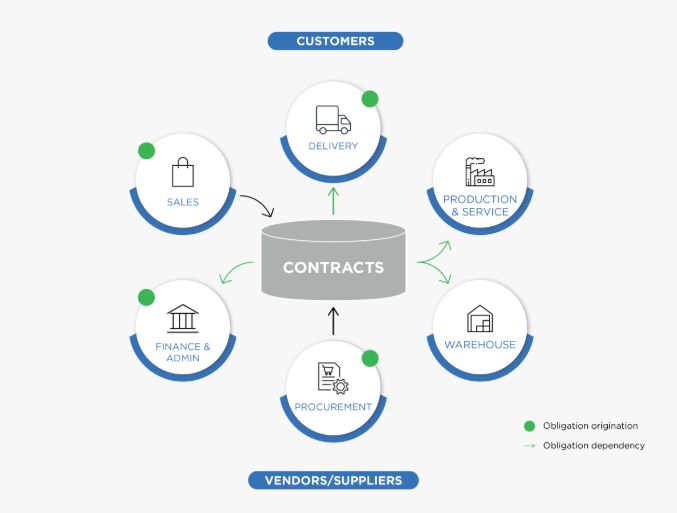
Figure 2: Conventional view of Enterprise Contract Management where obligations are viewed and managed in business silos
Even at organizations where contracts are centrally managed, obligation fulfillment may still be fragmented across the organization. It is estimated that at large organizations, 2% of revenue is lost due to missed obligations.
Therefore, the key questions that keep the CxO/senior leadership awake in the night are: Are we fulfilling all our obligations? Are we defaulting on any business/regulatory or statutory obligations?
That question is impossible to answer if obligations are not centrally managed and are not linked to various contracts that the organization has signed.
A McKinsey & Company study estimates leakage due to unfulfilled obligations at 2% in large enterprises. For an enterprise with $2 billion in annual spend, that adds up to $40 million a year. The identification and extraction of obligation is currently a human-vetted process, which is typically driven by the legal team and prone to human errors.
Some of the key challenges faced by companies dealing with Contractual Obligations are:
- A lack of insight and visibility into contractual obligations
- Fail to discover obligations
- A missed obligation can lead to costly litigation
- Unfulfilled obligation often strains business relationships and can cause reputational damage
- No defined workflow for completion of obligations and commitments
- No clear ownership of responsibilities
- Fail to gauge the implication of missed obligations
A new approach is an obligation centered on contract management. This approach extracts obligations from the ultimate source of truth that contracts are and centralizes them to improve visibility and performance.
The Solution Framework
The ICI Obligation Management App, built on top of the Icertis Contract Intelligence (ICI) platform, enables companies to execute this vision to drive compliance at enterprise scale, thereby building and protecting brand trust and improving business outcomes and most importantly ensuring that the business is always compliant. The ICI Obligation App provides an integrated environment that identifies and extracts existing obligations, risks, commitments from different ICI signed contracts to make them manageable, trackable, inheritable and contract centric compliant. The flexible architecture and configurable design of the platform allow users to configure and run a variety of obligations to their logical fulfillment. Given that the Obligation Management app is built on ICI Platform, implementations can easily configure dashboards & reports to have all-up views on overdue obligations.
The Capabilities
The ICI Obligation Management app helps customers address obligation requirements and get even more of their investment in the ICI platform. It offers these powerful capabilities for obligation management contracts:
- Automatic Obligation Discovery
- Automatically discover, extract, and setup obligations from any contract, through the power of artificial intelligence.
- Automatically discover, extract, and setup obligations from any contract, through the power of artificial intelligence.
- Flexible Setup & Creation of Obligations
- Create manual / time-based fulfillments from the identified contractual obligation such that system triggers fulfillments at appropriate points in time to enforce compliance.
- Create manual / time-based fulfillments from the identified contractual obligation such that system triggers fulfillments at appropriate points in time to enforce compliance.
- Rule-based Obligation Ownership
- Assign obligations to both internal and external users and automatically handle reassignments due to transfers, departures, etc.
- Seamless Obligation Fulfillment
- Generate and manage fulfillment processes using ICI tasks for internal users and for third-party users via the ICI Collaboration Portal or customized integrations. The out of box workflows for Obligations & Fulfillments will help review, approval of workflows to drive compliance.
- Easily control the process workflow by setting obligations on hold, withdraw, and cancel if required.
- Inherited Obligations Across Contracts
- Quickly setup rules to cascade and enforce obligations across related agreements – e.g. from MSAs to SOWs.
- Sophisticated Reporting & Analytics
- Track and monitor overdue fulfillments.
- Measure risk and compliance to deliver rolled-up insights across the enterprise.
The Examples
This section provides a sneak peek into some examples of contractual obligations and how they can be managed on the ICI Obligation Management app. These examples are intended to build a deeper intuition on what contractual obligations/fulfillments are, how obligations and fulfillments differ, and understand these from a lens of real world contracts.
As you scan through the agreement/clause texts, one can recognize statements which enforce an action and ownership in the form of “X entity shall perform Y” kind of statements. These are typically referred to as the contractual obligations.
The following examples are masked for customer/end-user references:
Example 1: Weekly SLA reports to track business/delivery performance.

Figure 4: An Excerpt from a SOW Agreement depicting the Weekly Reporting obligation in the Reporting clause
Example 2: Background validation for resources working on the account.
For any typical Customer Offshore Development (ODC) scenario in a IT Services, the company has an obligation to ensure any resources working in this ODC/Customer Account shall go through background verification. This might be an obligation enshrined in the MSA or any of the ongoing SOW Agreements. The following are some of the scenarios:
This is an ongoing obligation until the duration of the customer’s contract. The Obligation owner may choose to fulfill the obligation in a time-based fashion say at monthly frequency
- This is an ongoing obligation until the duration of the customer’s contract. The Obligation Owner may choose to fulfill the obligation in a time-based fashion, (such as monthly frequency).
- The Obligation Owner OR Accountable Person(s) for this obligation is the SOW Owner (typically, Project/Delivery Manager).
- The Fulfillment associated to this agreement would be owned by another function (such as HR). But, the Obligation Owner will certify of the Fulfillment is met or not.
- The Fulfillment’s owners (HR in this example) will upload the Fulfillment Evidence in the form of a file or a zip which is approved by the Obligation Owner.
The obligation in this example is on the Company to furnish the Audit reports to the Customer within a stipulated time (10 business days) when asked. This is not a time-based obligation, but will be manually accepted upon the event when the Customer asks for it. The Audit report can be submitted.
The Benefits
The key benefits of using the ICI Obligation Management App include the following:
- Significantly reduced risks by complying with all obligations - Identify and execute any implicit or explicit promises, duties, and accountabilities
- Reduced costs and contract turnaround time by automating the obligation lifecycle
- Improved customer and supplier relationships
- Better outcomes in contract negotiations and renewals
- Improved recovery of financial compensation for unfulfilled counterparty obligations
- Inherit obligation from the parent (MSA) to the child (SOW) to enforce compliance
- Cascade obligation changes from the parent (MSA) to the child (SOW) to enforce compliance
ObligationAI, Obligation Management and Commitments
We have some capabilities in the system which allude to the Obligation lifecycle. Here we describe the scope of each of them and clarify the scope entailed.
- Obligation AI (O/AI): As part of the Discover AI feature set, we have an ability to discover obligations from third party or own contracts. This capability helps assist the otherwise human process of manually discovering and extracting obligations from agreements. Once obligations are discovered, customers have the flexibility to integrate with the ICI Obligation Management app or any other third party integrated app.
- Obligation Management (OM): After obligations are discovered, either manually or through O/AI, we use the Obligation Management app capability to setup, track and monitor actual obligations. With dedicated entities called Obligation and Fulfillment, one can easily setup the ownership of obligation, setup the workflow to approve and agree with fulfillment evidence and track overdue fulfillments to have an all-up view of contractual compliance.
- Commitments: This capability is used to plan and perform agreement administration tasks. While some customers have tried using the Commitments capability to manage contractual obligations, there may be some limitations to managing the complete obligation lifecycle. Some of these include:
- Commitments are a light weight task and do not model the Obligation and Fulfillment entities or their workflow to manage the specialized Obligation lifecycle
- Commitments do not have an ability to create time-based fulfillments or capture fulfillment evidence which is core to the obligation management process
- Commitments have limited capability when it comes to configuring ownership, rules, notifications, etc. which are required by implementation teams
The Obligation Management Process
The obligation management process augments your contract management process by giving you effective tools to discover, identify and manage obligations through to fulfillment. There are various scenarios in which Obligation Management fits into the Contract management process. Some examples of these are:
Example 1: Post Agreement Execution
The focus during this scenario is to ensure that the right set of obligations are discovered (either manually or with Obligation AI discovery) and thereafter managed through the complete lifecycle. In this scenario since the agreement is executed, the obligations are also agreed upon, hence the focus here is to ensure they are tracked through the Contract’s lifetime.
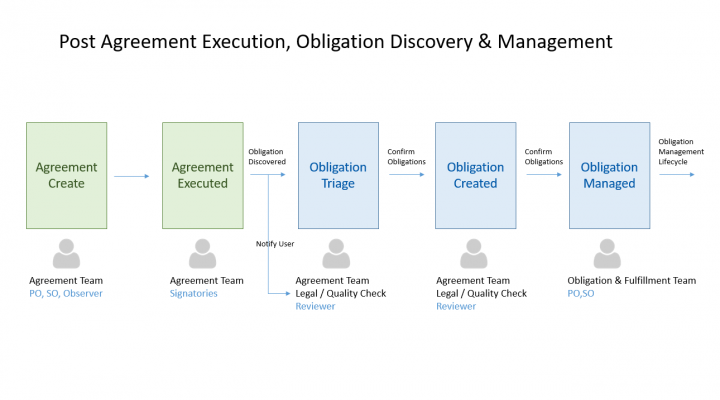
Figure 5: We can see the post-agreement execution phases for obligation discovery & management. We also call out the typical user roles that are involved in the process.
Example 2: During Agreement Negotiation
The focus during this phase is to use Obligations to assist the Agreement negotiation phase. When the Agreement edits, the Agreement Team would like to analyze the impact of change with respect to the obligations entailed.
The Obligation Management Workflow
This section describes the typical workflow for Creating, Reviewing, Accepting and Tracking fulfillments. The diagram below depicts the typical functions/user roles performing the respective operations.
Key Points to Note:
The Legal / QC functions typically read through the agreements to manually extract Obligations or use Obligations AI to triage and discover obligations. This role has enough legal knowledge to identify the right obligations that matter for the agreement and the business as a whole. The obligations are created in the Draft state.
- Once identified the Agreement Owners, typically the Primary/Secondary Owner on the Team will accept and approve the Obligations. Only after Obligation is approved, the obligations lifecycle begins.
- For approved Obligations, Fulfillment instances are spawned at the configured frequencies. It is also highlighted that the Fulfillments owner is different than the Obligations Owner.
- Fulfillment’s team is responsible for submitting the fulfillment evidence and send it for approval to the Obligation owner.
- If the Fulfillment is not approved before the due date, the fulfillment turns to overdue.
Working with Obligations
The ICI Obligation Management app introduces necessary ICI entities to track and monitor obligations for your Agreements. The app introduces ICIOMAppObligation & ICIOMAppFulfillment entities. These are seeded with required config, workflows, rules, metadata which can be extended as required for your implementation needs. These entities are of type Associated Document Contract Types as referred to in the ICI terminology.
Obligation & Fulfillments are associated docs seeded with the required configuration. It is expected that you configure your existing/new Agreements by setting the association as depicted in the diagram below. In the sections below we highlight the configuration for the Out Of The Box (OOTB) Entities and also recommend a configuration for implementation.
The OM app is using the construct of the “Association of Association”. The obligation is an association to your Agreement. And Fulfillment is an association to the Obligation.
The Out-of-the-Box Entity
The ICIOMAppObligation entity is used to model Obligations. It uses the Associated Documents Contract Type and can be used to associate with the required agreements. The following sections will cover the out of box configuration, functional behavior and recommended the configuration for implementation teams.
Contract Types
The Associated Document ICIOMAppObligation is seeded to track Obligations. It is expected that you will configure this seeded entity based on your implementation requirements.It is expected that you will configure this seeded entity to suite your implementation requirements.
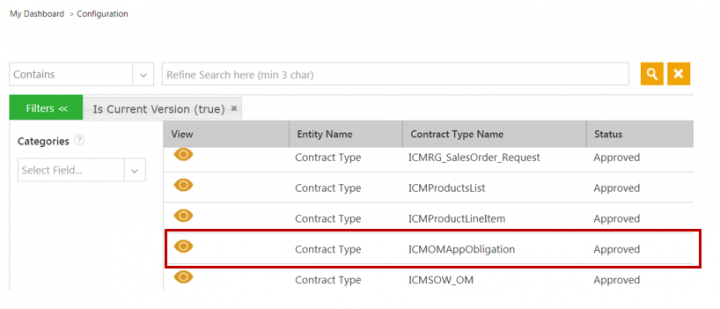
Figure 9: After you install OM, the configuration for Obligation entity is deployed for the instance
Seeded Attributes
The seeded attributes of ICIOMAppObligation are listed as per the categories below. Implementation teams can add new attributes for identifying, categorizing, tracking obligations as required.

* Attributes marked with asterisks are MANDATORY for creating the Obligation instance
Association
The ICI Obligation Management App is modeled on the Association of Association. The following association hierarchy exists.
- Agreement (Existing)
- Associated to → Obligation Association
- Associated to → Fulfillment Association
- Associated to → Obligation Association
It is expected for you to configure your existing Agreements to associate the Obligation Contract Type. We cover the details in Configuring your existing Agreement Contract Type to manage Obligations.
The following screenshot displays the Obligation’s association to Fulfillment which is seeded along with the app:
Masterdata
There three Masterdata Contract Types are seeded along with the ICI Obligation Management App:
- ICIObligationManagementSettings
- ICIOMAppLocationMaster
- ICIOMAppPartyMaster
These will be used by the ICI Obligation Management app for supporting future scenarios related to Location or Multi-party.
Rules
The ICI Obligation Management App has seeded the following set of rules. The contract type ICIOMAppObligation is configured with the following Rules:
The business rules that are critical to the flow of the application are now locked by the service users when deploying the Obligation Management application. This helps in preventing other users to unlock, edit and modify these rules, thus ensuring a smooth workflow.
For more information about Rules, refer to the ICI Obligation Management Configuration Guide.
Notifications
The ICI Obligation Management app has the following seeded notifications. Since the app is built on the ICI platform, implementation teams can configure notifications as required.
Recommended configuration to the Obligation Object
The recommended objects are the additional attributes provided along with the seeded attributes of ICIOMAppObligation to enhance the experience of The ICI Obligation Management app. Implementation teams can add new attributes for identifying, categorizing, tracking obligations as required.
The following are some of the recommended attributes:
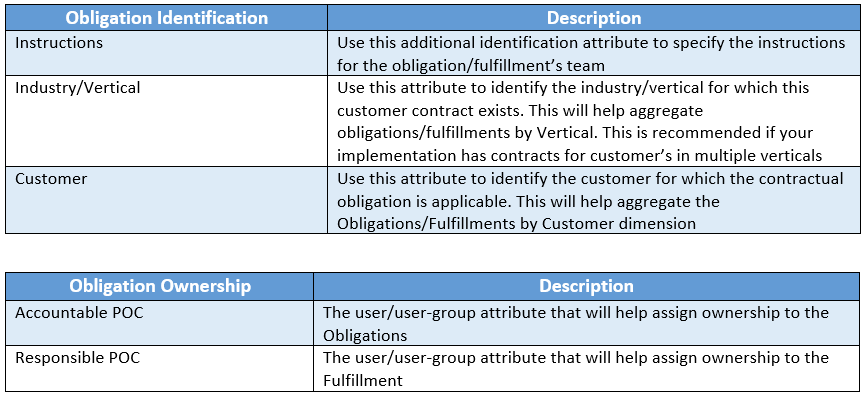
Configuring your existing Agreement Contract Type to manage Obligations
You can use your existing Agreements or configure new Agreements to manage obligations with ICI Obligation Management app. Let us now look into the configuring needed to your existing agreement contract type.
For example, if your implementation already has an Agreement Contract Type say MSA, the following steps show how to edit your config to start managing obligations:
1. Click the Configuration tile on the Dashboard. The Configuration page opens.
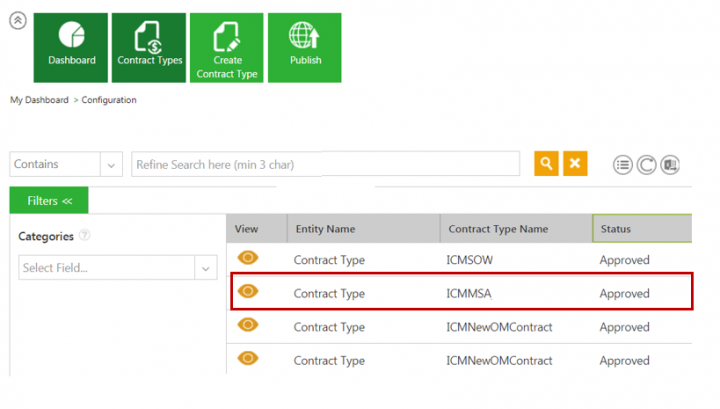
4. Click the View Record icon. The Contract Type Details page opens.
5. Click Edit. The Edit Contract Type page opens.
6. Click Next.
7. Toggle Yes in the Allow Third Party Paper field.
8. Toggle Yes in the Allow Clause Assembly field.
9. Toggle Yes in the Allow Copy With Associations field.
10. Click Next. The Attributes tab opens.
11. Select the attributes as per your requirement.
12. Click Next. The Association tab opens.
13. Click the plus icon to add an association. The Add Association section opens.
14. To inherit obligation, you need to select Obligation as Associated Contract Type.
15. Enter a name in the Association Name field. For example, Obligation.
16. Select Obligation from the Associated Contract Type drop-down.
17. Toggle Yes in the Allow Inheritance field.
18. Toggle Yes in the Multiple Inheritance field.
19. Click Save.

20. Click Next. The Display Preference tab opens.
21. Enter the details in the remaining tabs such as Display Preference, Team and Verify.
22. Click Update. The contract type MSA is updated with Obligation as Associated Contract Type.
Creating an Obligation for an Agreement
To create an agreement with an obligation:
1. Click the Agreement Management tile on the Dashboard. The Agreement Management page opens.

3. Enter all the details on the Create Agreement page. For example, MSA_OM.
4. Select Own in the Type Of Paper drop-down.

5. Click Next. The Attributes tab opens.
6. Enter the details in the remaining tabs to take it to Verify step.
7. Click Create and Publish. The Draft page opens.
Creating an Obligation with Time-Based Fulfillment
To create a Time-Based Fulfillment:
8. Click the Add icon to create an obligation. The Create Association – Obligation page opens.
9. Enter a name for the obligation. For example, SAAS obligation.
10. Enter the Description as per requirement.
11. Select a location from the Location dropdown.
12. Select a party in the Multi Party dropdown.
13. The Allow Inheritance field is already toggled to Yes. This allows the inheritance of approved obligations from the parent agreement to the child agreement. For example, MSA_OM to SOW_OM.
14. The Allow Fulfillment Tracking field is already toggled to Yes. This allows the system to track fulfillment instances.
15. Select Manual or Time-Based in the Frequency Type dropdown as per your requirement. For example, Time-Based. By setting it Time-Based will allow the system to instantiate the fulfillments at the set frequency and by setting it Manual user should manually add fulfillments to the obligation.
16. Select the fulfillment frequency in the Frequency dropdown. For example, Weekly. This will instantiate the fulfillment weekly.
17. Select a date in the 1st Fulfillment’s Due Date field. For example, December 16th, 2019. This date indicates that if fulfillment is not approved until its due date, it will move to the overdue state.
18. Select a date in the Overdue Buffer Days field. For example, 2. This date indicates the number of days that will be treated as a buffer after the due date. The system won’t treat a fulfillment as overdue during the buffer period.
* The Extended Due date field is automatically extended by 2 based on the Due Date. In this example, it is extended till December 18, 2019. The Extended Due Date is the summation of 1st Fulfillment’s Due Date and the value of Overdue Buffer Days.
* The system will treat a fulfillment as overdue after the extended due date is over.
19. Select a date in the End date field. For example, December 19, 2019. This date indicates the end date for fulfillment.
20. Select a file in the File Path field.
21. Select a POC in the Responsible POC dropdown.
The obligation is created with a Weekly fulfillment as shown in the screenshot below:
* Time-based Obligation & Time-Based Fulfillment
* Time-based Obligation & Manual Fulfillment
* Manual Obligation & Manual Fulfillment
To create an Obligation with Manual Fulfillment
Follow the steps from 9 to 17 mentioned in the section Creating an Obligation with Time- Based Fulfillment and then do the following:
1. Select Manual in the Frequency Type dropdown as per your requirement.
2. Select a date in the End date field. For example, December 16th.
3. Select a file in the File Path field.
4. Select a POC in the Responsible POC dropdown.
Approving Obligations
You can send the Obligation for approval as described in the following steps:
1. Click Send For Approval for the selected Obligation.
2. If the configured obligation is time-based, upon approval, the system generates the first instance of the Fulfillment.
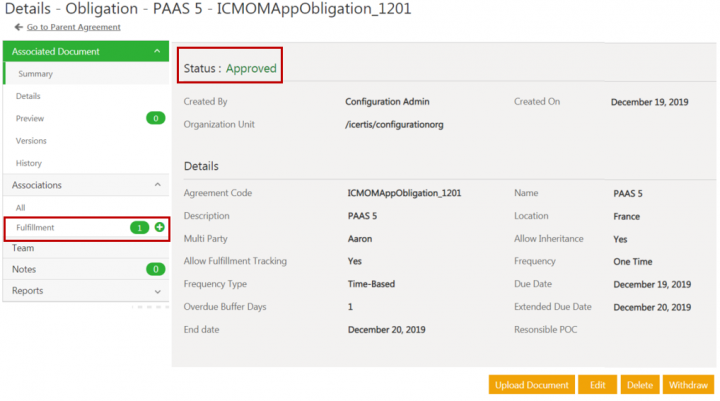
3. The Obligation’s Team can be configured for the approver role. When the Obligation is sent for approval, it will create an approval task to the approvers on its Team.
Applying Hold on Obligation
You can hold the Obligation based on default Role Action Mapping. You can hold an Obligation at Draft, Waiting For Approval, and Approved states.
If for some business reason, for a given obligation, it is required to hold some fulfillment instances, you can set the Obligation on Hold. This will prevent creating new fulfillment instances during the period of the hold. You can set the expiry date of the hold using the Hold Expiry Date attribute.
To apply a hold on an obligation:
1. Click Hold. The Association Hold Note window opens.

2. Enter a Hold Note.
3. Select the appropriate Reason Code.
4. Select a Hold Expiry Date. For example, 18/12/2019. The obligation gets released from hold on this day.
5. Click Add. The fulfillment state changed to the Cancelled state. All fulfillments that are NOT approved will be cancelled.
Releasing the Hold
You can release the hold before the Hold Expiry Date by clicking the Release Hold date.
6. Click the Release Hold button. The Association Release Hold window opens.

The status changes to Approved. The Obligation goes back to the previous state before it went on Hold. As seen in the above picture, that instance of Obligation went back to Approved state.
Applying Withdraw on Obligation
You can withdraw an obligation to send the obligation to Withdraw state and all user actions are removed.
To withdraw an Obligation:
1. Click Withdraw. The Association Withdraw window opens.
2. Enter a withdraw note.
3. Select the appropriate Reason Code.
4. Click Add.

The obligation is withdrawn and all its fulfillments that are not previously Approved will get Cancelled.
Replacing User in Obligations
You can replace a user in Obligation in the Team tab.
1. Click Team. The Add Team window opens.
2. Click Replace User.
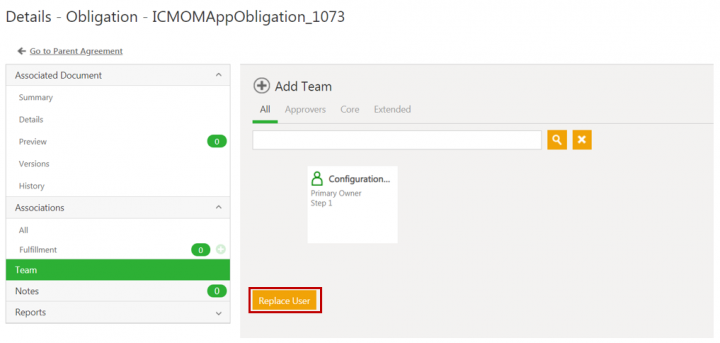
3. Select the User.
4. Enter Comments.
5. Select the Reason Code.
6. Click Add. The user is replaced.
Integrating Obligation AI with Obligation
Discovering obligations is the critical step to start Obligation Management lifecycle. Especially when there are hundreds of obligations in agreement, manually having to discover, triage, and create Obligations is a humanly exhaustive process.
Users can now track and manage Obligations for a given agreement using Obligation AI and Obligation Management for a seamless experience. The interconnected flow of AI with OM is aiming to solve Legal persona’s Job to triage, discover, and create obligations. With this feature we now can have cohesive experience to setting up obligations. This helps in yielding contract compliance and reducing the risks involved in managing contracts which primarily leads to:
- Reduce time and efforts to discover and create obligations.
- Use ICI’s human in loop model of consuming AI such that relevance of discovery become better over the time.
- Scale out the job of obligation discovery such that newer/junior members can effectively perform Obligation Management.
The default configuration is AI and Obligation Management as a combined one, and you can also configure individual as Obligation AI, or Obligation Management.
You can see Discover, and Manage under Obligation Tab in left pane as displayed in the image below:
You can perform the following actions on the Obligations:
- Confirm: To confirm the action and create the obligation based on the discovered data.
- Ignore: To ignore the discovered data and create the obligation later.
- Review Later: To review the discovered data later.
2. Click Confirm to confim the action. The Obligation Management page opens displaying the obligation details that are copied automatically.
The obligation details discovered by AI are filled automatically on the Create Obligation page in the Obligation Details field.
3. Enter all mandatory values of Attributes Frequency Type, and End date.
4. Click Create to Create Obligation.
5. Click Manage under Obligations Tab to confirm newly discovered obligations.
6. Click on Obligation Created, and obligation opens in new tab.
Obligation is opened in new window as seen in below image:
Note: You cannot perform any actions after the obligation is created.
Inheriting Obligations
Let us create an SOW contract type to understand inheritance in obligation from MSA_OM to SOW_OM.
Configuring your existing Agreement Contract Type to set Obligation Inheritance
Assuming that your instance has an SOW Agreement Contract Type, let us now edit its configuration to add association for tracking Obligations. After this, both our agreements MSA_OM & SOW_OM will start tracking Obligations.
Additionally, we will configure inheritance such that any Obligation that is approved in higher agreement type (e.g. MSA_OM) will be inherited to child agreement type (e.g. SOW_OM) in order to force compliance of contractual obligations.
1. Click the Configuration tile. The Configuration page opens.
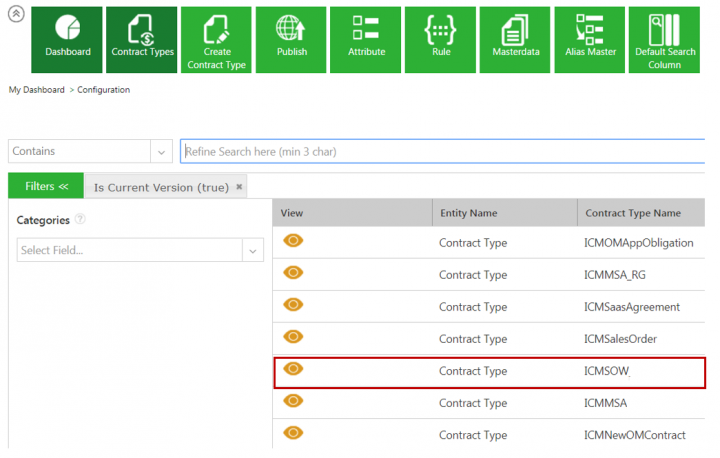
4. Click the View Record icon. The Contract Type Details page opens.
5. Click Edit. The Edit Contract Type page opens.
6. Click Next.
7. Toggle the Allow Third Party Paper field to Yes.
8. Toggle the Allow Clause Assembly field to Yes.
9. Toggle the Allow Copy With Associations field to Yes.
10. Click Next. The Attributes tab opens.
11. Select the attributes.
12. Click Next. The Association tab opens.
13. Click the plus icon to add an Association. The Add Association section opens.
14. To inherit obligation in SOW_OM, you need to select Obligation as Associated Contract Type.
15. Enter a name in the Association Name field. For example, Obligation.
16. Select Obligation from the Associated Contract Type drop-down.
17. Toggle the Allow Inheritance field to Yes.
18. Toggle the Multiple Inheritance field to Yes.
19. Click Save.
20. Enter the details in the remaining tabs such as Display Preference, Team, and Verify.
21. Click Update. The contract type SOW_OM is updated having an Associated Contract Type (Obligation).
Inheriting Obligations from Parent Agreement
Let us an example of inheriting obligations from the parent agreement (for example, MSA_OM obligations to SOW_OM).
1. Click the Agreement Management tile on the Dashboard. The Agreement Management page opens.
3. Select the Contract Type Name. For example, SOW_OM.
4. Select Third Party in the Type Of Paper drop-down field.
5. Click Next. The Attributes tab opens.
9. Click Select.
10. Enter the details in the remaining tabs to take it to Verify step.
11. Click Create and Publish.

All approved obligations of the MSA_OM agreement (Parent agreement) have been inherited by the SOW_OM agreement (Child). Any changes made to the parent contracts obligations have been cascaded to the child agreement's obligations.
Working with Fulfillments
The Out-of-the-Box Fulfillment Entity
The ICI Obligation Management App comes with a seeded Contract Type i.e. ICIOMAppFulfillment. As described earlier, Fulfillment is an association to the Obligation entity.
Contract Types
ICIOMAppFulfillment – This is an Associated Document Contract Type. It comes with a seeded set of attributes, workflow, rules & notifications. Implementation teams can easily tweak the configuration as per the customer’s requirements.
For more information about Fulfillment Contract Type, refer to the ICI Obligation Management Configuration guide.
Seeded Attributes
The following attribute values are copied from Obligation to the Associated Fulfillment:
- Agreement Code
- Fulfillment for Obligation
- Obligation Description
- Frequency Type
- Frequency
- Due Date
- Overdue Buffer Days
- Extended Due Date
- End Date
- Location
- Third Party or Vendor
The following attributes are used to capture Fulfillments completion:
For more information about seeded attributes, refer to the ICI Obligation Management Configuration Guide.
Rules
The ICI Obligation Management App is seeded with the default set of rules. The contract type ICIOMAppFulfillment is configured with the following Rules:

For more information about Rules, refer to the ICI Obligation Management Configuration Guide.
Creating & Editing Fulfillments
You can create Fulfillments manually for Obligations that have a frequency set to Time-Based OR Manual.
* Time-based Obligation & Time-Based Fulfillment
* Time-based Obligation & Manual Fulfillment
* Manual Obligation & Manual Fulfillment
Adding Fulfillment Evidence
The Fulfillment’s team is responsible for submitting the fulfillment evidence and send it for approval to the Obligation owner.
1. Click the Fulfillment tab under the Associations tab.
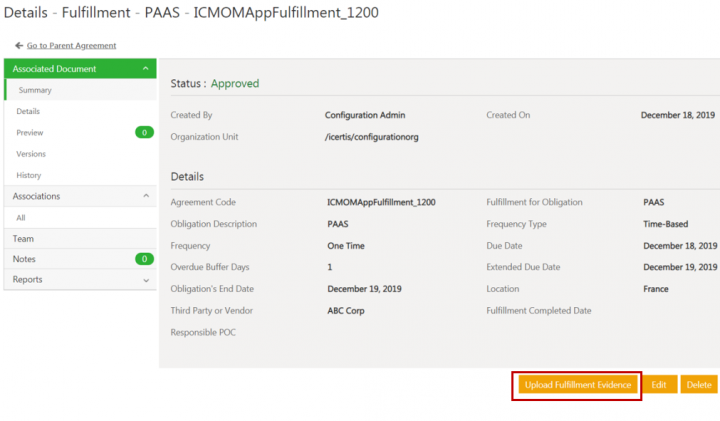
3. Click Upload Fulfillment Evidence. The Upload Document window opens.
4. Click Select File.
5. Click Upload File.

6. By uploading the fulfillment evidence, you need to send the fulfillment for approval to complete the fulfillment workflow.
Approving Fulfillments
The Fulfillments are approved by the Obligation owner by reviewing the submitted Fulfillment evidence. Let us look into an example:
1. Click the Fulfillment tab on the Details page.
Cancelling Fulfillments
By performing withdraw action the Fulfillments which are in Draft and Waiting for Approval state are moved to Cancelled state. Let us look into an example:
1. On the Details page, click Withdraw.

2. The Association Withdraw window opens.
3. Select a reason code from the Reason Code drop-down field.
4. Click Add.
Configuring Reports
The ICI Obligations Management app doesn’t come with inbuilt reports. However, since the ICI Obligation Management app is built on ICI platform, one can use the ICI capabilities for Search and Saved Searches to get an all-up view of Obligations and their Fulfillments. Additionally, you can use Saved Searches to set as Dashboard tiles.
Some examples of these reports as dashboard titles are given in the screenshots below:
Example 1: Total number of Obligations
Example 2: Total number of Fulfillments
Creating Obligations in Bulk using Bulk Actions
You can add existing agreements with obligations using Bulk Actions tile.
1. Click the Bulk Actions tile. The Bulk Action Management page opens.

2. Click Update Existing tile. The Update page opens.
3. Select the Bulk Upload Action. For example, Add Association To Agreement.
4. Select the Saved Search. For example, All Agreements.
5. Select the Contract Type Name. For example, ICIMSA_OM.
6. Select the Association. For example, ICIOMAppObligation.
7. Click Next.
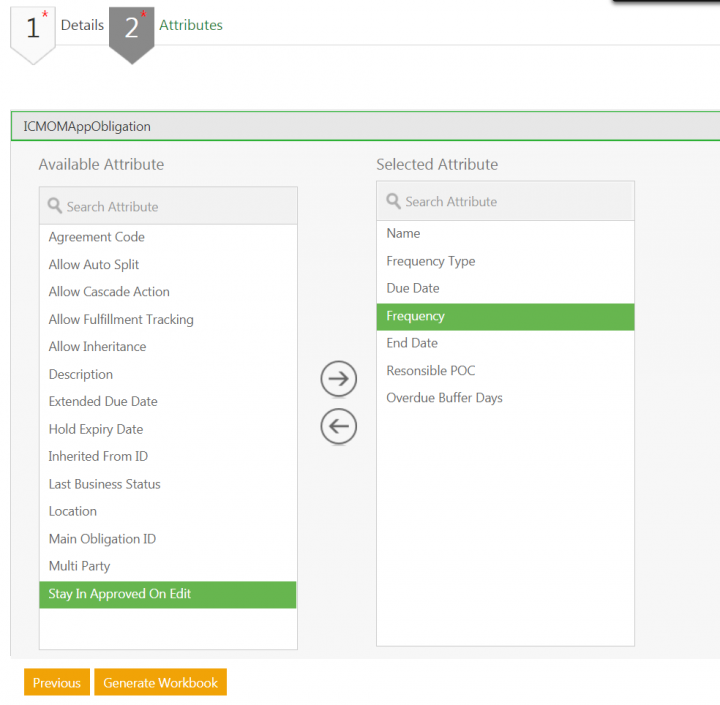
9. Click Generate Workbook.
10. Add the attribute values in the Workbook.
11. Save the Workbook.
12. Click Add Batch on the Bulk Action Management page.
13. Enter a Batch Name. For example, Obligation_MSA.
14. Select the Data file.
15. Click Add.
Glossary
We will cover the terms and concepts introduced with ICI Obligation Management App.
Known Issues
540450 – Obligations get inherited to parent MSA if the two-way linkage is configured.
In this release, support for two-way linkages is not supported.
If the two-way linkage is enabled, then Obligations gets inherited from the child agreement contract type (SOW) to parent agreement (MSA) on their approval, and there is an infinite loop.
Related Topics: Agreement Management | ICI Sourcing App | Obligation AI |
